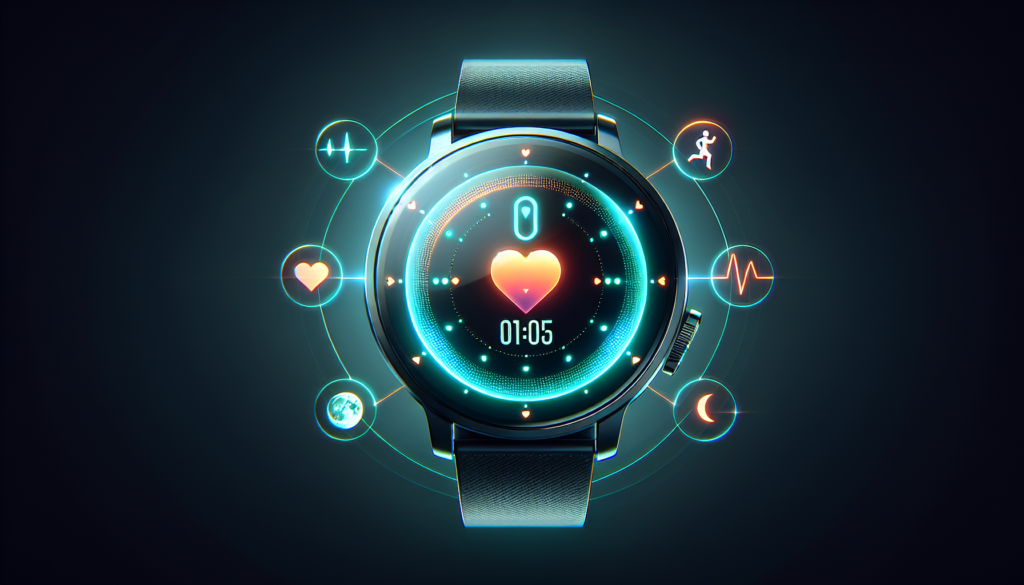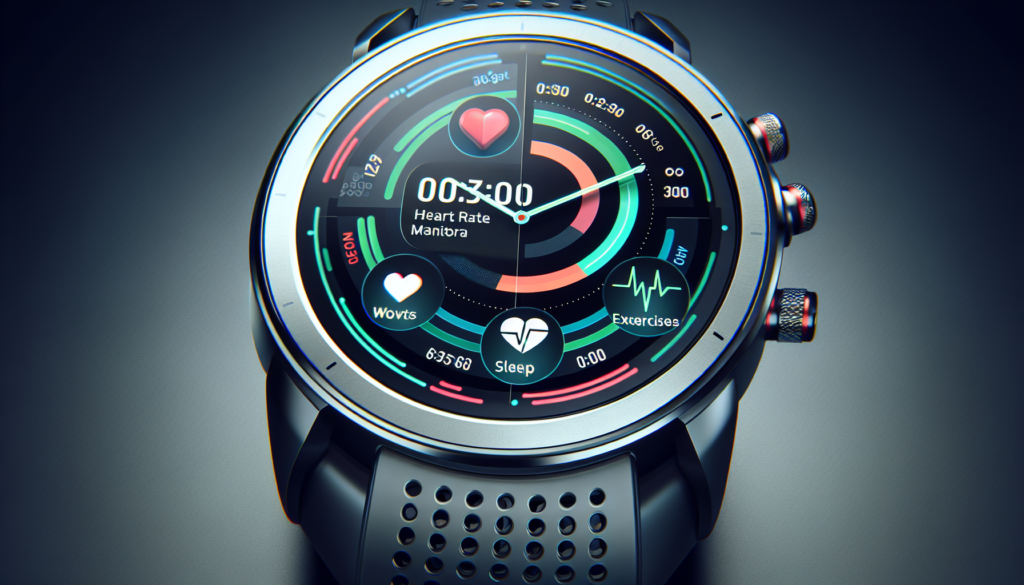Step into the world of wearable wellness with the ultimate guide to choosing a health smartwatch. Picture a future where your wrist becomes a hub of personalized health information and empowerment. These innovative devices are not just about collecting data passively, but about actively improving your well-being. From catering to specific needs like wheelchair accessibility to detecting pre-diabetes, these smartwatches are a revolution in health technology. With features like personalized wellness dashboards and biohacking capabilities, they unlock peak performance and open up a whole new world of possibilities. Join the conversation and explore the future of wellness with these accessible, inclusive, and empowering devices.
Consider Your Health Goals
When it comes to choosing a health smartwatch, it’s essential to first consider your health needs and goals. Take some time to reflect on what aspects of your health you want to monitor and improve. Are you looking to track your heart rate, improve your sleep patterns, or stay on top of your daily activity levels? Identifying your specific health needs will help you narrow down your options and choose a smartwatch that is tailored to your goals.
Once you have identified your health needs, it’s important to set specific goals for yourself. Setting specific goals can help keep you motivated and focused on achieving your desired health outcomes. For example, if you want to improve your fitness level, you might set a goal to reach a certain number of steps per day or to complete a certain number of workouts each week. Having clear goals in mind will guide your smartwatch selection process and ensure that you choose a device that can help you track and achieve those goals.
In addition to identifying your health needs and setting goals, it’s crucial to determine the necessary health features that are important to you. Consider what specific features you prioritize in a smartwatch, such as heart rate monitoring, sleep tracking, activity tracking, calorie counting, GPS tracking, stress and anxiety monitoring, blood pressure monitoring, or even EKG/ECG tracking. Understanding the health features that are essential to you will make it easier to evaluate and compare different smartwatches in the market.
Understanding Health Tracking Features
When selecting a health smartwatch, it’s important to understand the various health tracking features that are available. These features can help you gain valuable insights into your overall health and make informed decisions about your well-being. Here are some key health tracking features to consider:
Heart Rate Monitoring
Many smartwatches offer heart rate monitoring capabilities, allowing you to track your heart rate throughout the day and during exercise. This feature can help you determine your heart rate zones and ensure that you are exercising at an appropriate intensity level.
Sleep Tracking
Sleep tracking is another valuable feature offered by health smartwatches. These devices can monitor your sleep patterns, including the duration and quality of your sleep. By analyzing this data, you can gain a better understanding of your sleep habits and make adjustments to improve your overall sleep hygiene.
Activity Tracking
Activity tracking is a staple feature of health smartwatches, allowing you to monitor your daily movement and set activity goals. Whether you’re counting steps, tracking distance traveled, or monitoring your active minutes, this feature can help you stay motivated and on track with your fitness journey.
Calorie Counting
If weight management or calorie control is a priority for you, look for a smartwatch that offers calorie counting features. These devices can estimate your calorie expenditure throughout the day, helping you make more informed decisions about your nutrition and overall calorie intake.
GPS Tracking
For outdoor enthusiasts or those who enjoy running or cycling, GPS tracking is a must-have feature. With GPS capabilities, your smartwatch can accurately track your route, distance covered, and pace, providing valuable insights into your outdoor activities.
Stress and Anxiety Monitoring
In today’s fast-paced world, stress and anxiety monitoring have become increasingly important. Some smartwatches now offer features like stress tracking and guided breathing exercises to help you manage and reduce stress levels.
Blood Pressure Monitoring
If you have hypertension or are concerned about your blood pressure, consider a smartwatch that offers blood pressure monitoring. These devices can provide you with real-time blood pressure readings and help you keep track of your cardiovascular health.
EKG/ECG Tracking
Certain high-end smartwatches now include EKG/ECG tracking features, which can detect irregular heart rhythms that may be indicative of more serious health conditions. If you have a history of heart problems or simply want to keep a closer eye on your heart health, this feature can be incredibly beneficial.
Understanding these different health tracking features will help you determine which ones are most important to you and make an informed decision when choosing a smartwatch.
Compatibility and Connectivity
When selecting a health smartwatch, it’s crucial to consider its compatibility and connectivity options to ensure seamless integration with your existing devices and lifestyle.

Operating System Compatibility
One key consideration is the operating system compatibility of the smartwatch. Most smartwatches operate using either the Apple Watch OS or Google’s Wear OS. Ensure that the smartwatch you choose is compatible with your smartphone’s operating system to ensure smooth synchronization and data sharing.
Smartphone Compatibility
In addition to operating system compatibility, it’s important to consider if the smartwatch is compatible with your specific smartphone model. Some smartwatches may have limited functionality or connectivity issues with certain smartphone brands or models. Check the compatibility guidelines provided by the manufacturer to ensure that the smartwatch and smartphone are compatible.
Wireless Connectivity Options
Wireless connectivity options are another important factor to consider. Many smartwatches offer Bluetooth connectivity, allowing you to wirelessly sync data with your smartphone or other devices. Some advanced models may also offer Wi-Fi or NFC connectivity, enabling additional features and functionality. Consider the connectivity options that are essential to you and ensure that the smartwatch you choose supports them.
Taking compatibility and connectivity into account will ensure that your smartwatch seamlessly integrates with your existing devices, making it easier to access and analyze your health data.
Battery Life and Charging
The battery life and charging capabilities of a health smartwatch are crucial factors to consider to ensure that the device can keep up with your daily activities and monitoring needs.
Battery Life Expectations
Different smartwatches have varying battery life expectations, depending on factors such as display type, features used, and frequency of use. Consider your personal usage patterns and how long you would like the battery to last on a single charge. If you’re an active individual who frequently uses various features throughout the day, you may want to opt for a smartwatch with a longer battery life.
Charging Methods and Time
Additionally, it’s important to consider the charging methods and time required for the smartwatch. Some smartwatches use wireless charging, while others require traditional wired chargers. Determine which charging method is most convenient for you and ensure that the smartwatch’s charging time aligns with your lifestyle. For example, if you need a quick charge before heading out for a workout, choose a smartwatch with fast charging capabilities.
Considering the battery life expectations and charging aspects of a smartwatch will ensure that you can use your device effectively without running out of power at inconvenient times.
Display and Design
The display and design of a health smartwatch play important roles in both functionality and aesthetics. Consider the following factors to find a smartwatch that meets your needs and personal style.
Screen Resolution and Readability
A high-resolution screen improves readability and enhances the overall experience of using a smartwatch. Look for a smartwatch with a bright and clear screen that displays essential health data and notifications in a legible format. Adjustable brightness settings are also a bonus, especially for outdoor activities in bright sunlight.
Touchscreen or Button Interface
Decide whether you prefer a touchscreen or button interface for navigating your smartwatch. Touchscreens offer intuitive and easy-to-use interfaces, while button interfaces provide tactile feedback and convenience, especially during workouts or when hands are wet. Consider your personal preference and how you plan to use the smartwatch in various situations.
Water Resistance and Durability
For individuals who enjoy swimming or water-based activities, it’s crucial to choose a smartwatch with water resistance. Look for a device that has an appropriate water resistance rating, allowing you to track your exercise and health data while in the water. Additionally, consider the overall durability of the smartwatch, especially if you lead an active lifestyle or plan on wearing it during intense workouts or outdoor adventures.

Style and Customization Options
Lastly, consider your personal style preferences and the customization options available for the smartwatch. Some devices offer interchangeable straps or customizable watch faces, allowing you to personalize the look of your smartwatch to match your individual style. Opt for a smartwatch that not only meets your functional needs but also complements your fashion sense.
Taking these display and design factors into account will help you find a smartwatch that is visually appealing, functional, and suitable for your lifestyle.
Health App and Data Integration
The ability to seamlessly integrate with health apps and platforms is essential for maximizing the potential of your health smartwatch. Consider the following aspects when evaluating the health app and data integration capabilities of a smartwatch.
Supported Health Apps and Platforms
Check if the smartwatch is compatible with the health apps and platforms you already use or plan to use. Integration with popular platforms like Apple Health or Google Fit can ensure that your health data is consolidated in one place, making it easier to track your progress and share information with healthcare professionals, if needed.
Data Synchronization and Integration
Evaluate how the smartwatch syncs and integrates with your chosen health apps and platforms. Some devices offer seamless synchronization through cloud services or wireless connections, while others require manual data transfers. Consider your preferred method of data management and select a smartwatch that aligns with your preferences.
Ensuring that your smartwatch can effectively integrate with your preferred health apps and platforms will streamline your data management process, providing a comprehensive view of your health and wellness journey.
Smartwatch Apps and Functionality
Beyond health tracking, smartwatches often offer a range of apps and additional functionalities. Consider the following factors when assessing the available apps and features of a smartwatch.
Available Apps and Features
Evaluate the range of apps and features available on the smartwatch. Look for apps that align with your interests and provide added value beyond health tracking. For example, if you enjoy listening to music during workouts, a smartwatch with music streaming capabilities may be a desirable feature.
Customization and Personalization Options
Consider the level of customization and personalization the smartwatch offers. This includes the ability to download and personalize watch faces, adjust app settings, and customize notifications. A highly customizable smartwatch can be tailored to your preferences and enhance your overall user experience.
Assessing the available apps and functionality, as well as the customization options, will ensure that you can maximize the utility and enjoyment of your smartwatch beyond health tracking.
Price Range and Budgeting
Estimating your budget and setting a price range is an important step when choosing a health smartwatch. Consider the following factors to determine an appropriate budget for your purchase.
Set a Budget
Decide how much you are willing to spend on a health smartwatch and set a budget accordingly. Consider your financial situation and how much value you place on the features and functionalities that the smartwatch offers. This will help you narrow down your options and avoid overspending.
Consider Long-Term Value
When setting your budget, consider the long-term value of the smartwatch. While a higher-priced model may seem expensive initially, it may offer additional features, durability, and customer support that contribute to its long-term value. Evaluate the trade-offs between upfront cost and long-term value to make an informed decision.
Compare Prices and Features
Research the prices and features of different smartwatches within your budget range. Compare the offerings of various brands and models to ensure that you are getting the best value for your investment. Consider factors such as warranty, customer support, and software updates when comparing prices and features.
By establishing a budget and comparing prices and features, you can make a well-informed decision that aligns with your financial situation and desired functionality.
Customer Reviews and Ratings
Researching customer reviews and ratings can provide valuable insights into the reliability and satisfaction of a health smartwatch. Consider the following points when evaluating customer reviews.
Research Customer Reviews
Read customer reviews from reputable sources to gain a deeper understanding of the smartwatch’s performance and user experience. Look for both positive and negative reviews to get a balanced perspective and consider how the feedback aligns with your priorities.
Consider Reputable Sources
Ensure that you’re consulting reputable sources for customer reviews, such as professional review websites, tech publications, or trusted online retailers. These sources often provide unbiased and in-depth assessments of the smartwatches they review, helping you make an informed decision based on reliable information.
Look for Overall Satisfaction and Reliability
Pay attention to overall customer satisfaction and reliability of the smartwatch. Look for patterns in reviews to identify any potential issues or areas of excellence. A smartwatch with consistently positive reviews and high ratings is more likely to meet your expectations and provide a reliable user experience.
By researching customer reviews and ratings, you can gain insights into the real-world performance of a health smartwatch and make a decision based on the experiences of other users.
Warranty and Customer Support
Considering the warranty and customer support options of a health smartwatch is important to protect your investment and ensure a positive ownership experience.
Check Warranty Details
Review the warranty details provided by the manufacturer. Look for information on the duration of the warranty, what it covers, and any potential limitations or exclusions. A longer warranty period and comprehensive coverage can provide peace of mind and protect your investment against potential defects or issues.
Research Customer Support Reputation
Research the reputation of the smartwatch manufacturer’s customer support. Look for reviews and feedback regarding their responsiveness, helpfulness, and overall customer satisfaction. A manufacturer with a strong customer support reputation is more likely to address any issues or concerns you may have with your smartwatch promptly and effectively.
Understand Repair and Replacement Policies
Understand the repair and replacement policies of the smartwatch manufacturer. Familiarize yourself with the process and any associated costs for repairs or replacements. A transparent policy with reasonable terms and conditions can ensure that you have a hassle-free experience in case of any issues with your smartwatch.
Considering the warranty and customer support options will provide you with peace of mind and assurance that the smartwatch manufacturer stands behind their product.
In conclusion, choosing a health smartwatch involves careful consideration of your health goals, understanding the available health tracking features, evaluating compatibility and connectivity options, assessing battery life and charging capabilities, considering display and design aspects, examining health app and data integration capabilities, exploring smartwatch apps and functionalities, setting a budget, researching customer reviews and ratings, and taking into account the warranty and customer support options. By following this comprehensive guide and considering these factors, you can make an informed decision and select a health smartwatch that best suits your needs and preferences. Embrace the future of wearable wellness and unlock the potential of a health revolution right on your wrist!

